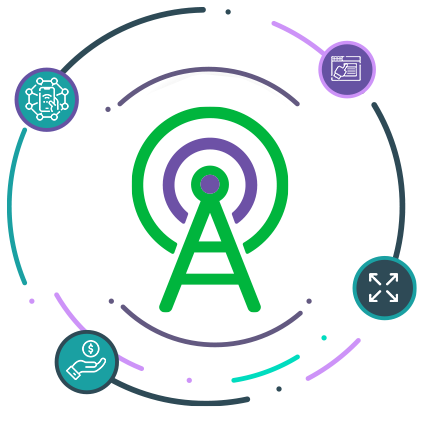Let’s be brutally honest: if your telecom network is still relying solely on
traditional SS7 infrastructure, you’re playing a dangerous game. While
Signalling System No. 7 (SS7) has long been the trusted backbone of telecom
signalling, the rules of the game have changed. The traffic is heavier, the
expectations are higher, and clunky legacy systems just aren’t cutting it
anymore. That’s where SIGTRAN in telecom enters the picture — and frankly,
it’s the upgrade your network can’t afford to ignore.
Not only is it expensive to scale, but it also lacks the flexibility and agility needed to support modern, fast-paced service deployment. Telcos trying to innovate while being shackled to traditional signalling networks are essentially trying to stream Netflix over dial-up.
With SIGTRAN, telcos are no longer tied to expensive, aging hardware or locked into inflexible, monolithic systems. You can move faster, integrate smarter, and adapt quicker—three things your competitors are already doing.
In other words, SIGTRAN Gateway is the translator, the negotiator, and the enabler of innovation all rolled into one.
This dual-approach supports everything from subscriber info retrieval (RestoreData, SendIMSI) to complex interactions like authentication vector extraction or MNP call control integration. Think of it like having both manual control and cruise control in a high-performance car — use whichever suits the road ahead.
The case for a SIGTRAN Gateway isn’t about jumping on the latest trend. It’s about aligning with the reality of modern telecom: speed, agility, and efficiency are non-negotiable. If your network can’t deliver that, someone else’s will.
With over 27 years of telecom innovation under their belt, hSenid Mobile’s SIGTRAN Gateway is a fully in-house built, software-based SIGTRAN stack. No third-party dependency. No clunky SS7 cards. Just effortless integration into operator environments with proven, carrier-grade deployments.
So, what’s the move?
If you’re ready to ditch the baggage of legacy SS7, embrace the flexibility of IP-based signalling, and actually empower your teams to innovate, start with the hSenid SIGTRAN Gateway. Because in today’s network economy, innovation waits for no one. Learn more about hSenid’s SIGTRAN Gateway today.
The Legacy Load: When SS7 Starts to Show Its Age
We all respect SS7. It’s been the workhorse behind everything from call control and SMS delivery to mobile roaming and prepaid billing. But as telcos pivot towards delivering high-demand value-added services, things like location-based marketing, mobile payments, and real-time data services, the cracks in traditional SS7 infrastructure are becoming too obvious to ignore.Not only is it expensive to scale, but it also lacks the flexibility and agility needed to support modern, fast-paced service deployment. Telcos trying to innovate while being shackled to traditional signalling networks are essentially trying to stream Netflix over dial-up.
Enter SIGTRAN: Signalling, Supercharged
This is where SIGTRAN, often described as SS7 over IP, becomes a game-changer. It allows the transport of SS7 signalling messages over IP networks, using protocols like SCTP (Stream Control Transmission Protocol) to ensure reliable delivery. The big win? You maintain the reliability of SS7 while gaining the cost-effectiveness, scalability, and flexibility of IP-based systems.With SIGTRAN, telcos are no longer tied to expensive, aging hardware or locked into inflexible, monolithic systems. You can move faster, integrate smarter, and adapt quicker—three things your competitors are already doing.
The Real MVP: SIGTRAN in Telecom
Now, here’s where things get interesting. At the heart of this transformation lies the SIGTRAN Gateway (SIGTRAN GW), a smart, powerful interface that bridges your applications with the underlying SIGTRAN stack. It’s the enabler that lets your internal systems talk to the telecom network using HTTP APIs, pulling critical data from elements like the HLR (Home Location Register) or MSC (Mobile Switching Centre).In other words, SIGTRAN Gateway is the translator, the negotiator, and the enabler of innovation all rolled into one.
Why Your Network Needs a SIGTRAN Gateway — Yesterday
- Cost Efficiency: Replacing SS7 cards and proprietary hardware with software-driven gateways saves serious money.
- Faster Service Deployment: With exposed APIs, new services can be rolled out in days, not months.
- Scalability: As demand grows, IP-based signalling scales with ease. No forklift upgrades.
- Flexibility: Loosely coupled architecture means new integrations won’t break the system.
- Future-Proofing: You’re setting the stage for next-gen services. 5G, IoT, and cloud-native solutions all require agile signaling.
Flow vs Direct: Two Flavors of API Brilliance
A robust SIGTRAN Gateway doesn’t just offer one way in—it provides multiple layers of abstraction based on your use case. Direct API Calls allow your applications to trigger SIGTRAN operations directly via HTTP, perfect for low-latency integrations. Meanwhile, Flow API Calls are initiated by the gateway itself, streamlining complex workflows and ensuring smooth coordination with the core network.This dual-approach supports everything from subscriber info retrieval (RestoreData, SendIMSI) to complex interactions like authentication vector extraction or MNP call control integration. Think of it like having both manual control and cruise control in a high-performance car — use whichever suits the road ahead.
Real-World Use Cases That Demand a SIGTRAN GW
- USSD Gateway Integrations
- Location-Based Service Platforms
- SMSC and HLR Integrations
- Authentication for Mobile Offloading
- Multi-SIM Routing
- MNP Interworking for Fixed Line Traffic
Evolution or Extinction?
Telecom isn’t what it used to be, and that’s a good thing. But if your signalling infrastructure hasn’t evolved with it, you’re not just falling behind. You’re putting your entire service portfolio at risk.The case for a SIGTRAN Gateway isn’t about jumping on the latest trend. It’s about aligning with the reality of modern telecom: speed, agility, and efficiency are non-negotiable. If your network can’t deliver that, someone else’s will.
And Here’s the Best Part…
With all this talk about SIGTRAN in telecom, one name keeps coming up among operators looking to stay ahead of the curve: hSenid Mobile.With over 27 years of telecom innovation under their belt, hSenid Mobile’s SIGTRAN Gateway is a fully in-house built, software-based SIGTRAN stack. No third-party dependency. No clunky SS7 cards. Just effortless integration into operator environments with proven, carrier-grade deployments.
So, what’s the move?
If you’re ready to ditch the baggage of legacy SS7, embrace the flexibility of IP-based signalling, and actually empower your teams to innovate, start with the hSenid SIGTRAN Gateway. Because in today’s network economy, innovation waits for no one. Learn more about hSenid’s SIGTRAN Gateway today.








